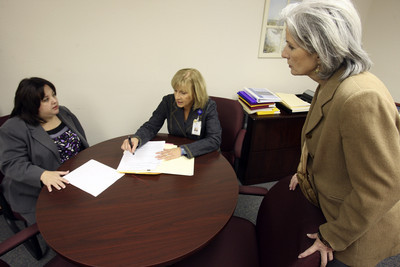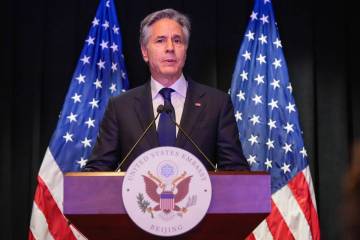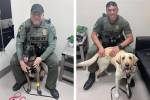Tracking tuberculosis patients
It began with a telephone call in December 2007.
A man in his mid-20s to early 30s had been admitted into a Las Vegas hospital with active tuberculosis.
Because tuberculosis is a deadly infectious disease, hospitals must notify the Southern Nevada Health District when they receive a case.
But in this case the hospital didn't telephone in a timely manner, and the man left the facility before anyone from the health district could interview him.
What transpired next was a near year-long investigation by the health district's TB control staff who contacted more than 500 known associates of the elusive man, an illegal immigrant with more than a dozen aliases.
Many of those the district contacted were then tested for TB.
Eight tested positive.
Two of the infected were young children.
And had it not been for the health district's determination in locating the man, one child might have died, said Laurie Hickstein, the health district's senior public health nurse.
Eventually, the man's true identity was discovered. The district will not release his name or identify the Las Vegas hospital to which he was admitted, citing privacy laws. But officials said he was from Mexico, had been previously deported, and was part of a notorious drug ring known for beheading its rivals.
Without the cooperation of a key witness he still could be roaming the Western United States and spreading the disease.
Ultimately in May, nearly six months after that first phone call, the man was located at a hospital in Maricopa County, Ariz., where he spent months receiving antibiotics to treat his active tuberculosis.
Stephen Minagil, the health district's former staff attorney, had gotten a court order to keep the man hospitalized until after his treatment.
He now is cured, but the investigation will forever remain on the minds of the health district's TB control staff. For one, it highlights the importance of disease investigators, said Dr. Lawrence Sands, the district's chief health officer.
"Disease investigations are critical to prevent further spread of disease in our community,'' Sands said. "Disease investigators have to be able to identify cases as well as the extent of the illness among those who are sick; identify potential sources; and who should be tested or treated to end an outbreak."
Even though countless hours were spent interviewing uncooperative witnesses and running into roadblocks, the health district's TB staff said it was worth it.
"We had to put bits and pieces together, because this case was like one huge detective story,'' Hickstein said. "We potentially saved lives and this state millions of dollars in locating this one individual.''
ONE DISEASE, MANY DILEMMAS
According to the federal Centers for Disease Control and Prevention, tuberculosis is a deadly disease caused by bacteria that attack the lungs and other areas of the body. In the category of infectious diseases, it is the leading cause of death in the country.
Tuberculosis is spread through the air, from one person to another, but not everyone infected becomes ill. People who do not become ill have what is known as latent TB infection. They do not have any symptoms and cannot spread TB to others. But they still need treatment.
People with active TB, on the other hand, are dangerous because they can spread the disease rapidly, which is a reason health authorities become proactive when an infected person is identified, said Bonnie Sorenson, manger of the health district's clinics.
Nevada ranks among the top 20 states with the highest rates of TB. At any given time in Clark County, 80 or more people under the health district's supervision are receiving treatment for active TB. Last year, the health district identified 91 new active TB cases. In 2007, there were 93.
In a March 24 announcement regarding World TB Day, Sands said about 55 percent of Clark County's TB patients are foreign-born.
Though deadly, tuberculosis is curable. Adherence to treatment is key to eliminating the risk of spreading TB. That can take six to 24 months and requires supervision.
The health district's public health nurses visit or speak with active TB patients five times a week to ensure treatment compliance and make sure other needs, such as nutrition and shelter, are met.
But when people don't comply with their regimen, drug-resistant strains of TB can develop. A handful of such cases have been identified in Southern Nevada.
"They don't like the isolation or the stigma associated with it,'' said Patricia O'Rourke-Langston, supervisor of the health district's tuberculosis program.
In such cases, the health district may be required to use outside resources to monitor compliance.
Those resources include the police, the U.S. Marshal's Service and homeless organizations. Sometimes, drastic measures such as involuntarily quarantining must be used when people try to evade the health district, she said.
For example, the health district in one case obtained a court order to put a GPS monitoring system on an infected individual.
The order originally sought to have the person jailed, based on the premise that he was a public health threat, O'Rourke-Langston said. But there was concern about overcrowded conditions in the Clark County Detention Center.
"We went back to court and had the order amended that said, 'OK, in lieu of going to jail you will wear the GPS device.' ''
The health district also had to provide housing and transportation to the man while he wore the GPS.
Hickstein said it isn't uncommon for the district's tuberculosis program to use funding from its own budget to house patients as well as provide treatment and transportation.
In one instance, roughly $300,000 to $400,000 was allocated from the health district's budget over a seven-year period to house a woman with drug-resistant tuberculosis.
Including the housing, medications, doctor and emergency room visits this woman had access to in that seven year period, the costs to care for her probably exceeded $1 million, they said.
The woman came to Las Vegas in 2002 from Amargosa Valley and was known as a "frequent flier" in hospitals because she would go in and out of emergency rooms seeking pain medications. She often was uncooperative.
Eventually, the health district worked with other health care providers, namely University Medical Center, to ensure she received proper and timely care in a less restrictive environment.
The woman agreed to a portocath, a small catheter inserted in her upper chest wall allowing medications to be administered to patients on an outpatient basis.
Her tuberculosis was finally cured late last year, nearly seven years after the health district made contact with her.
Hickstein said in another situation, a man was placed in involuntary isolation inside his own home. To check on him, the health district would contact him by video phone. If he didn't respond to the videophone, "then we went to the house.''
Such cases illustrate dilemmas the health district faces in controlling the spread of diseases in Southern Nevada.
Although the infected are considered threats to the community, the health district is limited in its authority. Being sick is not a crime, just as refusing care or voluntary quarantine isn't breaking the law. A court order is needed in cases of involuntary quarantine, usually in cases where people are uncooperative.
Almost daily the health district balances protecting the public with being mindful of citizens' civil rights. At what point is involuntary quarantine appropriate? And how much should taxpayers pay to keep a disease from spreading?
"People need to recognize that the goal of the program is to identify and cure the disease and that we're not the enemy," Sorenson said. "We're not trying to compromise their lifestyles, and I think that's the perception some people have. If we didn't track these people and TB ran rampant in our community, the costs would be astronomical."
All health care providers are supposed to alert the health district when a patient tests positive for tuberculosis.
Linda Dey, a former infection control nurse at Valley Hospital Medical Center, said she would be notified when an emergency room patient is suspected of having TB. She would call the health district's TB clinic to determine if the patient was in their program.
"The patient doesn't have to be a TB case for me to suspect them,'' Dey said. "The reason being is that TB is not determined real rapidly.''
If the patient is ruled out as having TB, the hospital has no authority to hold the patient.
But if the hospital's staff has reason to believe the patient does have TB, it can hold that person in isolation for a short while.
In the short-term, the hospital has the option of using its security staff until the health district's staff arrives and takes control of the case, Dey said.
On the trail
In the case of the man involved in the drug cartel, it wasn't just the hospital's slow response that caused problems for the health district. Adding to the challenge was the hospital staff's inability to provide a physical description or his real name.
Health district officials asked the hospital for security surveillance tapes. But that request met resistance from security staff, which initially complained that reviewing footage would take too long. Eventually, health officials narrowed the time period when the man would have entered the emergency room.
The footage failed to show the man. What it did show was a friend whom health district staff recognized. They had met the friend after treating an inmate at the Clark County Detention Center in April 2006. (The district is required to make contact with associates of TB patients.)
The inmate turned out to be the one for whom health officials were looking.
"We had treated him for a month," Hickstein said of the 2006 encounter. But one day, "we went down to the jail and poof, he was gone. ICE (Immigration and Customs Enforcement) had taken him away.''
Though the man dropped off the health district's radar once he was deported, the agency notified a San Diego-based international TB organization of his illness. The organization works with the United States to keep track of people with active TB in Mexico.
"We were able to get information about where he was going so that we could send him a referral to a clinic,'' Hickstein said.
Even after connecting those dots, the case presented more hurdles. For one, the man had used his friend's brother's identification that December 2007 day he checked into the hospital.
Though that was a piece of the puzzle, it wasn't particularly helpful. The friend was not easy to track down, and associates would not cooperate.
Eventually, the friend came to the health district's offices and began providing details.
The problem with her story was "she didn't know his real name. She was dealing with nicknames and aliases,'' Hickstein said.
But the friend did provide a crucial detail that helped crack the case: The man had fathered a child with a young girlfriend, and that child had become ill.
"Then we were on high alert,'' O'Rourke-Langston said. "We need to find the baby.''
Through more detective work, disease investigators used health district records to locate the baby and the mother. The health district issues birth certificates, which contain information about a newborn's parents.
At first, the family was reluctant to speak. They didn't trust the health district, and they knew the man's criminal background and feared him.
The mother also was uncooperative, even though she was in a relationship with a man who had tuberculosis. But a relative who had children of her own figured the health district was only there to help.
"She began telling us that we were dealing with an individual who was in a gang and that they were actively selling drugs,'' Hickstein said.
Health district investigators made contact with dozens more people, some of whom were drug dealers as well.
"One of the contacts who was part of the drug crew was shot in the head," O'Rourke-Langston said.
She said agency officials heard and read accounts of beheadings by this cartel.
At one point, the relative of the mother notified the health district that the man they sought was in Arizona. His car had broken down there. Because he was sick, he told them he was headed to a hospital for care.
"We were right on that,'' O'Rourke-Langston said. "We were able to send photos of the individual to nearby hospitals, alerting them that he might be coming into their emergency room.''
When he showed up in the Maricopa County hospital, he was held through the court order that Minagil, the health district's former counsel, had sought. He was treated for six months until he was cured.
The child, and seven others the man infected, were successfully treated for tuberculosis. Health district officials do not know the man's whereabouts.
"We spent a lot of money from our reserves investigating this very rare case,'' O'Rourke-Langston said. "But, at the same time, we probably prevented a lot of people from contracting tuberculosis. That prevention was worth every penny."
Contact reporter Annette Wells at awells@reviewjournal.com or 702-383-0283.





























